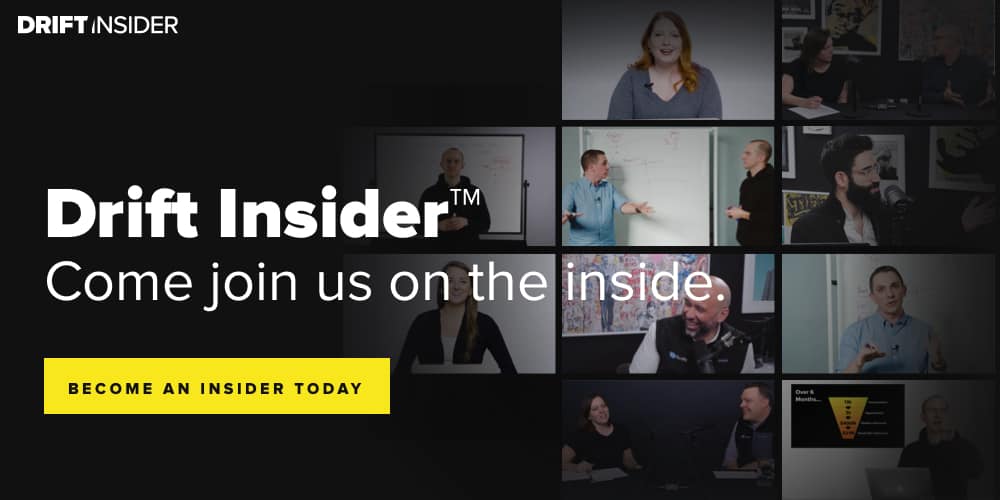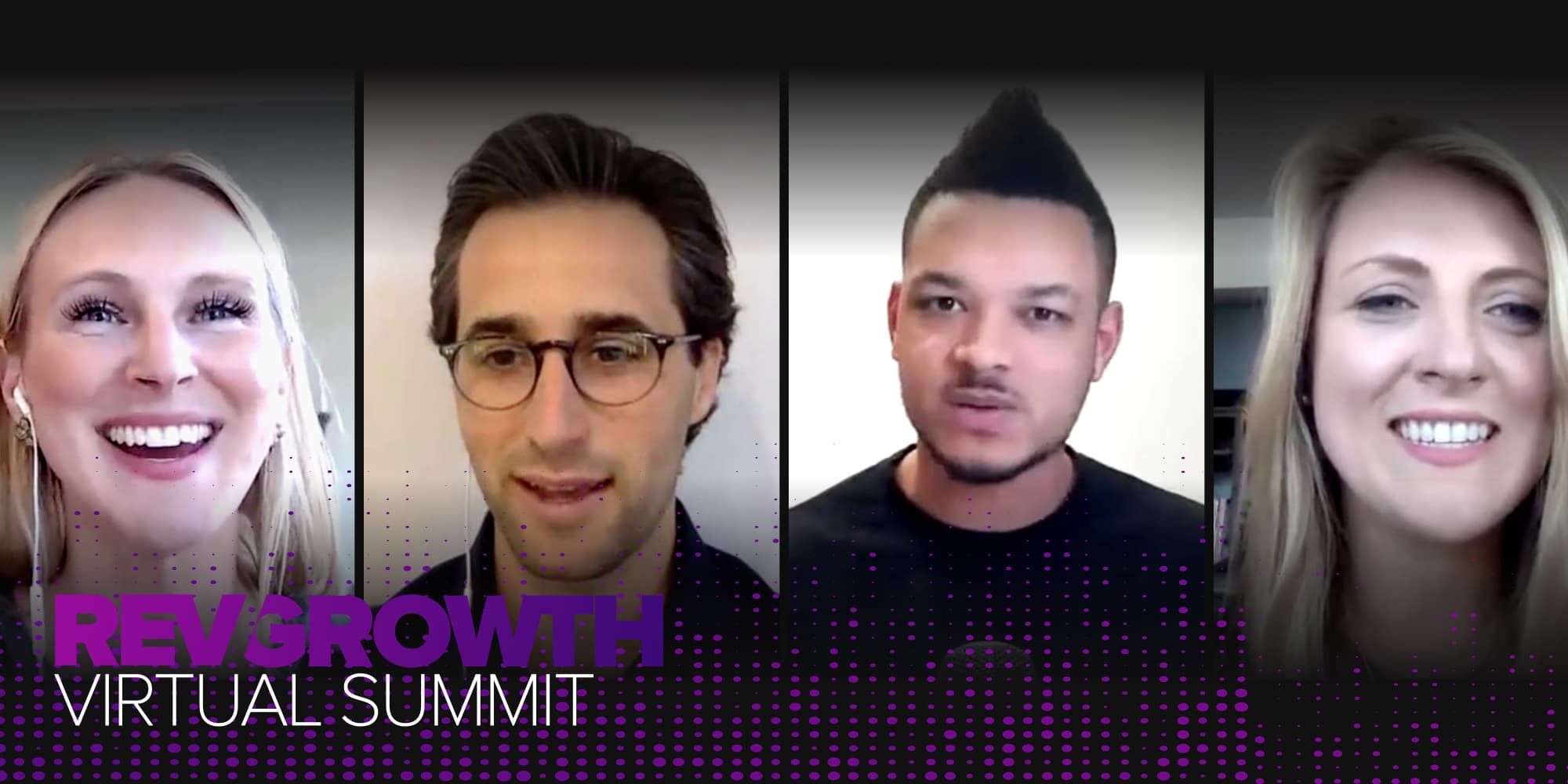
Swag is often a point of contention in marketing.
For pro-swaggers, swag is a key tactic to drive engagement, business, and employee morale. For anti-swaggers, swag is a black hole in the marketing budget, seen as nothing more than a fluff exercise.
If the title didn’t already give it away, we’re Team Swag here at Drift.
Call it fluffy all you want, but moments like these are reason enough to keep us invested ?
Thanks @MattBilotti and @drift for the swag! Using #DriftVideo on a weekly basis. Awesome product. pic.twitter.com/tpitznnCey
— Tyler Stahle (@tstahle15) July 15, 2019
But that doesn’t mean we aren’t abundantly cautious and intentional when it comes to our swag.
Over the last year and a half, I’ve helped create and shape our swag engine 2.0 at Drift.
“Engine” is the word we like to give internal processes that – with a little love and attention – become so operationalized and well-documented that anyone can run it. Matilda or no Matilda.
Now, I’m revealing the secrets behind Drift’s swag engine, including how we:
- Sliced our swag budget by 70%
- Built an on-demand swag machine for sales to drive revenue
- Use swag to drive employee retention, engagement, and morale
As a bonus, I’m also including a spreadsheet template – so you can follow along and build your own swag engine from scratch:
Get the Template
Before we get into all that, let’s first dig into why swag is important for closing B2B business and celebrating employees.
Why Swag Is Important & How to Use It
When you strip B2B demand generation strategies down to the bare bones, many of the touchpoints and channels start to look the same.
And therein lies why swag is so important.
Swag enables marketing and sales teams to create memorable moments that aren’t easily replicated by the next guy. Swag also drives bottom-line results – when executed correctly.
But don’t just take it from me: The folks at Outreach and Sales Hacker conducted an A/B test to see how buyers react to swag during the sales process and if swag influenced pipeline acceleration. During the experiment, only half the buyers were sent swag.
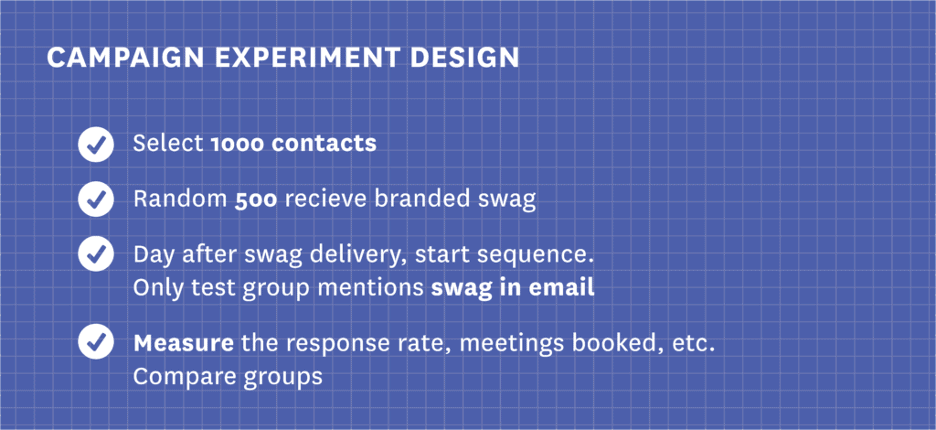
Source: Kotis Design, Does Sending Swag to Prospects Work?
Once the campaign ended, the results were clear. The swag group:
- Had a 26% increase in response rates
- Was three times more likely to book a meeting
- Had a higher opportunity value (2.42x increase)
Swag works. Especially during critical milestones in a buyer’s journey.
Swag can also be used during an employee’s lifecycle with a company. From onboarding to anniversaries to wins, swag is a great way to make employees feel connected and valued by a company.
But how can you make swag scalable? For the rest of this blog, I’ll share how to build an engine for sales, plus how Drift uses swag to create memorable moments for employees.
Building an On-Demand Swag Engine for Sales
Swag budgets left unchecked can easily snowball costs and lead to misaligned branding.
In this section, I’ll run through how you can create an on-demand swag engine that doesn’t break the bank, aligns with branding and marketing guidelines, and scales as your team grows.
Creating Your Swag Engine
Like other marketing teams, Drift began feeling the burden of manually orchestrating swag outreach for sales.
More than that, we weren’t getting the best bang for our buck. So we went back to the drawing board. We reevaluated our inventory, brought on a vendor to help scale and integrate with our CRM, and started calculating what additional needs we had with our growing sales team.
Cue the swag math ?

I live for spreadsheets. But if you’re like 99% of people who look at this with dread, no worries. The point here is to try and understand your inventory needs over time and the budget you’ll need to get you there.
Identify the Inventory You Need & for Which Teams
To start building a swag engine, begin by assessing what swag you have already.
Once you identify what you have, focus on what you want. For the sake of example, let’s say you want t-shirts, hats, and books, and that you’re building this engine for a sales team of 20.
You’ll probably give more budget to your account-based marketing (ABM) or enterprise account executives, who traditionally have more decision-makers in their sales cycles. For our example, we have:
- 15 reps that cover small to midsize businesses
- 5 reps for ABM/enterprise accounts
Now you have to start budgeting. Here, you’ll need to solve three issues:
- How much you want to spend upfront on inventory
- How much you plan to spend per month on shipping
- How you want to package your inventory
Let’s say you’re able to order in bulk and get some deals (highly recommended). In our example, we have the following bulk purchase options:
- 150 hats at $10 a piece ($1,500)
- 100 t-shirts at $20 a piece ($2,000)
- 100 books at $15 a piece ($1,500)
- All in total for inventory = $5,000
Now that we know how much inventory we have, we can cluster some of that inventory. Earlier I mentioned that we have ABM/enterprise reps. For these folks, we want to give them a higher-end bundle for special occasions. Based on our inventory, this would be all three items combined:
- 30 full bundle swag items (hat, t-shirt, book)
- 120 hats
- 70 t-shirts
- 70 books
Let’s get down to the all-in cost if this is our inventory. Below you see a table with a breakdown ?

Based on the amount of inventory, you’re spending $8,480 on swag. However, this doesn’t tell you how much inventory and budget you need to make your swag last.
How to Make Your Swag Last
For our example, you want to make sure this inventory lasts at least six months. So, you need to figure out how much inventory you’ll need. Once we know this, we can start to assign sales reps budgets.
This is often where eyes start to glaze over, but stay with me. It’s an important part of keeping costs under control and keeping the right inventory in stock.

Here’s how to do it:
- You decide to give each team 50% of the inventory (i.e., 290 total inventory * 50%). Each team in this case gets 145 items. That number is how much we would give reps each month if we wanted to spend all our swag in one month:
- ABM has 5, so 145/5
- Mid-size has 15, so 145/15

- To calculate for six months, you take the “per rep number” and divide it by the number of months you want your swag to last. For example, ABM 29 per rep so:
- Month one = 29/1
- Month two = 29/2
- Month three = 29/3
- By the time you get to month six, you can give each rep – depending on what team they’re on – either five swag sends a month or two. And you can keep playing around with these numbers, but you’ll only adjust the percentage by team and your formulas will do the rest.
Depending on what swag vendor you use, you can either assign reps a monetary-based budget or an item-based budget.
You can then work with your swag vendor to package the inventory. A good swag vendor will integrate seamlessly into your CRM, making it easy for reps to send packages on their own.
The beauty is that you’ll have the rules in place on the backend to keep things within budget ?
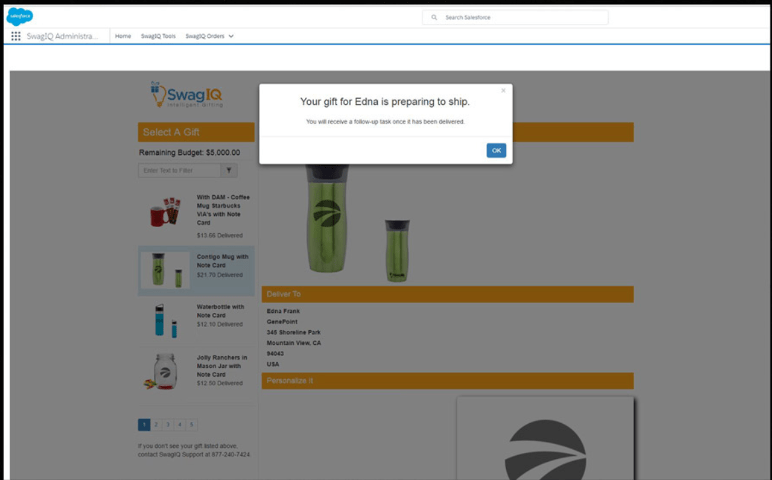
Pre-Launch: Align with Sales & Get Budget Approved
Once you’ve done all the hard work to build out your swag engine, you need to align with sales and gut check that your system works.
Connect with two of your top reps from each segment. Run them through the proposal. Get feedback on:
- If they think the amount of swag is enough
- If the swag options will resonate with buyers
Once you get feedback from your reps, we’ll need to get your swag engine approved. Start building a proposal and presentation.
Depending on who you’re presenting to, you might need more than one meeting. For example, if you need to present to leadership and get budget approval, the presentation will have different information than your presentation to sales (they care about different things, so they should have different messaging).
Launch: Running Your Swag Engine
Once your budget and engine are approved, meet with the sales team and show them how the system works. Then, share your enthusiasm with the company and team ?
Remember to keep tabs on your engine. You may need to make budget adjustments or tweak the process. This is the first time you’re launching the engine, so be flexible to change.
Finally, listen to feedback from your buyers and customers! Identify the impact swag is having on not just your bottom line, but your customer experience ?
Thanks @Drift for the cool swag and Conversational Marketing book! #thefutureofmarketing pic.twitter.com/5VVS4h793b
— Morgan Wiedmann (@mwiedd) March 27, 2019
Using Swag to Excite & Delight Employees
Swag is also a powerful tool for showing appreciation to your employees and boosting morale.
At Drift, we are lucky to have the amazing Becky Garber, manager of Drift Experiences at Drift. Becky is the gatekeeper for our swag and the go-to person for aligning the Drift brand with our swag needs:
“We try exceptionally hard to create swag that is high-quality and appropriately designed to match current fashion trends. We want people to want to wear these items and not feel like they are a walking billboard for a “software company.” It’s a fun way to allow your employees to participate with the brand and feel a sense of honor when wearing it.”
Becky works with members of her team to plot when and how to use swag for employees at Drift. Here are some of my personal faves:
- Onboarding: Each employee receives a swag pack with a sweatshirt, t-shirt, stickers, notepad, and more.
- 2nd year anniversary: Employees receive a Drift branded jacket (and a little plant).
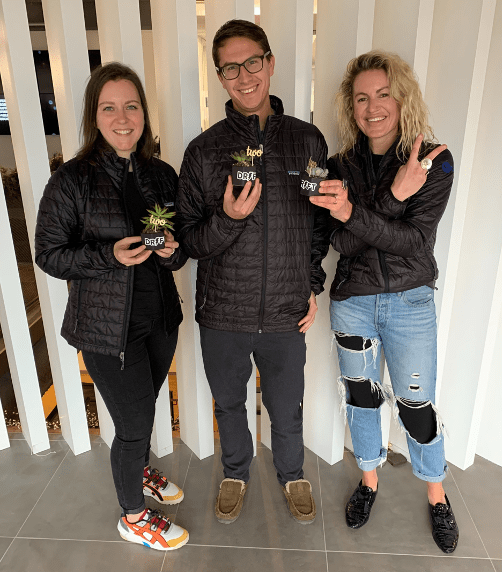
- Life moments: If any of our employees have a baby or adopts, they will receive swag geared towards the new member of their family (blanket, onesie, etc.).
Thanks for the onesies @Drift! Our little preemies are finally growing into them! pic.twitter.com/nJtvqOxDNv
— Jamie Gregory (@jamielgregory) July 13, 2018
- Thank you’s: We use higher-end swag for employees that have gone above and beyond. Limited-edition swag is also given out as prizes at various internal events.
- Celebrations: Custom swag is created for specific events such as Pride, International Women’s Day, races (marathons, bike races, softball teams, etc.).
While work-from-home has made it slightly more challenging to celebrate these moments, we’re still doing our best to make sure employees feel the love (even at home).
Final Thoughts
It’s safe to say swag is a big part of the Drift culture – and our marketing and sales strategy.
If my math didn’t scare you away, I wish you the best-of-luck in building your own swag engine! (Here’s that template again to get you started.)
And remember: Swag isn’t just for customers. Celebrate your employees and keep them engaged too.




